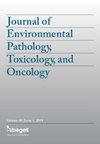Identification of Lung Adenocarcinoma Subtypes by Using Growth Hormone-Releasing Hormone-Related Genes and Establishment of Signature to Predict Prognosis and Guide Immunother
IF 2.9
4区 医学
Q3 TOXICOLOGY
Journal of Environmental Pathology Toxicology and Oncology
Pub Date : 2024-08-01
DOI:10.1615/jenvironpatholtoxicoloncol.2024053370
引用次数: 0
Abstract
Background: Growth hormone-releasing hormone (GH-RH) and its antagonists are believed to influence the progression of varying tumor diseases. However, the specific effects of GH-RH-related genes on lung adenocarcinoma (LUAD) are yet to be deciphered. Methods: GH-RH-related gene set data, LUAD transcriptome data, and clinical data were available for download at GeneCards, TCGA, and GEO databases. R software was implemented to finish differential, regression, cluster, survival, and tumor microenvironment analyses. Drugs associated with model genes were predicted using CellMiner database. Results: 781 LUAD samples (TCGA-LUAD: 600 cases; GSE50081: 181 cases) and data for 1555 GH-RH-related gene sets were obtained from public datasets. Two LUAD subtypes with different GH-RH gene expressions were identified through cluster analysis. Significant differences were unveiled in prognosis between the two subtypes. A prognostic risk scoring model was generated based on genes screened from the PPI network, and afterward, the model was validated. The model comprised 7 genes, specifically CLCA1, CYP17A1, DKK1, IGF2BP1, IGFBP1, RPE65, and VGF. Immune-related analysis revealed significant differences in immune cell infiltration levels between high and low-risk groups (P<0.05), with mast cells and neutrophils showing significantly higher infiltration levels in the low-risk population than the other group. Conclusion: The 7-gene signature in the current study is of paramount importance for predicting overall survival and immune microenvironment of LUAD patients.利用生长激素释放激素相关基因识别肺腺癌亚型,建立预测预后和指导免疫治疗的特征基因组
背景:生长激素释放激素(GH-RH)及其拮抗剂被认为会影响各种肿瘤疾病的进展。然而,GH-RH 相关基因对肺腺癌(LUAD)的具体影响尚待破解:方法:在GeneCards、TCGA和GEO数据库中下载GH-RH相关基因组数据、LUAD转录组数据和临床数据。使用R软件完成差异分析、回归分析、聚类分析、生存分析和肿瘤微环境分析。利用CellMiner数据库预测了与模型基因相关的药物:从公共数据集中获得了781个LUAD样本(TCGA-LUAD:600例;GSE50081:181例)和1555个GH-RH相关基因组的数据。通过聚类分析,确定了两种具有不同 GH-RH 基因表达的 LUAD 亚型。两种亚型的预后存在显著差异。根据从 PPI 网络中筛选出的基因生成了一个预后风险评分模型,随后对该模型进行了验证。该模型包括 7 个基因,分别是 CLCA1、CYP17A1、DKK1、IGF2BP1、IGFBP1、RPE65 和 VGF。免疫相关分析显示,免疫细胞浸润水平在高风险组和低风险组之间存在显著差异(P<0.05),其中肥大细胞和中性粒细胞在低风险人群中的浸润水平明显高于其他组别:本研究中的 7 个基因特征对预测 LUAD 患者的总生存率和免疫微环境至关重要。
本文章由计算机程序翻译,如有差异,请以英文原文为准。
求助全文
约1分钟内获得全文
求助全文
来源期刊
CiteScore
3.80
自引率
0.00%
发文量
20
审稿时长
>12 weeks
期刊介绍:
The Journal of Environmental Pathology, Toxicology and Oncology publishes original research and reviews of factors and conditions that affect human and animal carcinogensis. Scientists in various fields of biological research, such as toxicologists, chemists, immunologists, pharmacologists, oncologists, pneumologists, and industrial technologists, will find this journal useful in their research on the interface between the environment, humans, and animals.

 求助内容:
求助内容: 应助结果提醒方式:
应助结果提醒方式:


